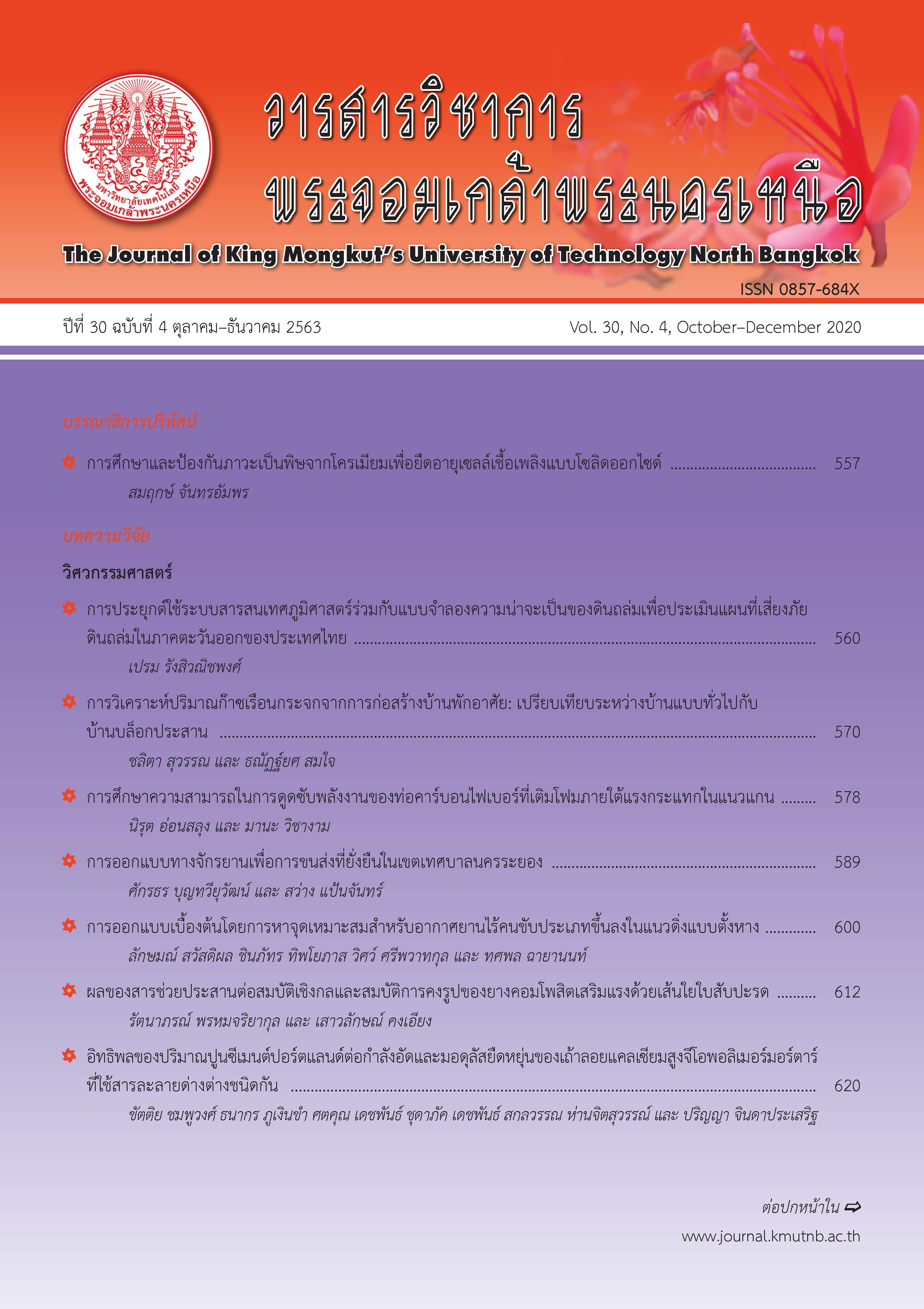การศึกษาความสัมพันธ์ระหว่างเกาะความร้อนเมืองและจำนวนนักท่องเที่ยวในตัวเมืองเชียงใหม่ด้วยเทคนิคการรับรู้ระยะไกล
Main Article Content
บทคัดย่อ
งานวิจัยนี้มีวัถตุประสงค์เพื่อประเมินปรากฏการณ์เกาะความร้อนเมืองแบบรายเดือนในตัวเมืองเชียงใหม่ และศึกษาความสัมพันธ์ระหว่างปรากฏการณ์เกาะความร้อนเมืองกับจำนวนนักท่องเที่ยว โดยอาศัยข้อมูลอุณหภูมิจากภาพถ่ายดาวเทียม Terra ระบบ MODIS (MOD11A1) ความละเอียดเชิงพื้นที่ 1,000 เมตร แบ่งเป็นช่วงเวลากลางวันและกลางคืน และสถิติจำนวนนักท่องเที่ยวแบบรายเดือนตั้งแต่ พ.ศ. 2556 ถึง พ.ศ. 2560 ผลการศึกษาทำให้ทราบว่า ตัวเมืองเชียงใหม่เกิดปรากฏการณ์เกาะความร้อนเมืองในทุกเดือนโดยสามารถสังเกตความแตกต่างของอุณหภูมิเกาะความร้อนเมืองในพื้นที่เมือง และพื้นที่รอบนอกได้ชัดในช่วงกลางวันของฤดูร้อนคือ ช่วงเดือนกุมภาพันธ์ถึงเดือนมิถุนายน และฤดูหนาวคือ ช่วงเดือนธันวาคม และมกราคมในบางปี แต่ช่วงเดือนที่เกิดปรากฏการณ์เกาะความร้อนเมืองสูงสุดอยู่ในช่วงเดือนสิงหาคมถึงตุลาคม การศึกษาความสัมพันธ์ระหว่างเกาะความร้อนเมืองกับจำนวนนักท่องเที่ยวพบว่า มีความสัมพันธ์ในเชิงบวกโดยค่าความสัมพันธ์ในเวลากลางคืนสูงกว่ากลางวัน แต่ค่าความสัมพันธ์ของปริมาณทั้งสองอยู่ในเกณฑ์น้อย อย่างไรก็ตาม การประเมินปรากฏการณ์เกาะความร้อนเมืองจากนักท่องเที่ยวทำให้ทราบถึงข้อมูลเชิงพื้นที่ที่สามารถนำมาใช้เป็นข้อมูลสำหรับการวางแผนเพื่อรองรับการท่องเที่ยวได้อย่างมีประสิทธิภาพยิ่งขึ้นในอนาคต
Article Details
บทความที่ลงตีพิมพ์เป็นข้อคิดเห็นของผู้เขียนเท่านั้น
ผู้เขียนจะต้องเป็นผู้รับผิดชอบต่อผลทางกฎหมายใดๆ ที่อาจเกิดขึ้นจากบทความนั้น
เอกสารอ้างอิง
[2] T. R. Oke, “City size and the urban heat island,” Atmos. Environ, vol. 7, no. 8, pp. 769–779, 1973.
[3] N. Theetawatwong, “The concept for mitigating urban heat island in high density: Case study of Silom road,” M.S. thesis, Graduate School, Silpakorn University, Bangkok, 2015 (in Thai).
[4] P. Ruthirako, “The application of GIS to urban heat island study in Hatyai City Municipality and suburban area,” Research report, Hatyai University, Songkhla. 2015 (in Thai).
[5] Y. Abbassi, H. Ahmadikia, and E. Baniasadi, “Prediction of pollution dispersion under urban heat island circulation for different atmospheric stratification,” Building and Environment, vol. 168, no. 106374, pp. 1–19, 2019.
[6] J. Quan, Y. Chen, W. Zhan, J. Wang, J. Voogt, and M. Wang. “Multi-temporal trajectory of the urban heat island centroid in Beijing, China based on a Gaussian volume model,” Remote Sensing of Environment, vol. 149, pp. 33–46, 2014.
[7] Q. Weng, D. Lu, and J. Schubring, “Estimation of land surface temperature–vegetation abundance relationship for urban heat island studies,” Remote Sensing of Environment, vol. 89, no. 4, pp. 467–483, 2004.
[8] N. Phengphit, S. Karnchanasutham, K. Nualchawee, and P. Soytong, “The study of correlation between land surface temperature with urban and building area, a case study of Amphoe Mueang Rayong, Rayong province, Thailand,” Journal of Geoinformation Technology of Burapha University, vol. 2, no. 3, pp. 27–40, 2017 (in Thai).
[9] W. Charoentrakulpeeti and N. Mahawan, “Temporal and spatial dimensions of urban heat island in Chiang Mai,” Journal of the Faculty of Architecture King Mongkut’s Institute of Technology Ladkrabang, vol. 19, no. 2, pp. 162–172, 2014 (in Thai).
[10] V. Miles and I. Esau, “Seasonal and spatial characteristics of urban heat islands (UHIs) in northern West Siberian cities,” Remote Sensing, vol. 9, no. 10, pp. 989–1004, 2017.
[11] W. Wang, K. Liu, R. Tang, and S. Wang, “Remote sensing image-based analysis of the urban heat island effect in Shenzhen, China,” Physics and Chemistry of the Earth, Parts A/B/C, vol. 110, pp. 168–175, 2019.
[12] C. Dian, R. Pongrácz, Z. Dezs , and J. Bartholy, “Annual and monthly analysis of surface urban heat island intensity with respect to the local climate zones in Budapest,” Urban Climate, vol. 31, pp. 100573–100589, 2020.
[13] H. Li, F. Meier, X. Lee, T. Chakraborty, J. Liu, M. Schaap, and S. Sodoudi, “Interaction between urban heat island and urban pollution island during summer in Berlin,” Sci Total Environ, vol. 636, pp. 818–828, 2018.
[14] M. L. Imhoff, P. Zhang, R. E. Wolfe, and L. Bounoua, “Remote sensing of the urban heat island effect across biomes in the continental USA,” Remote Sens. Environ., vol. 114, no. 3, pp. 504–513, 2010.
[15] C. Keeratikasikorn and S. Bonafoni, “Satellite images and Gaussian parameterization for an extensive analysis of urban heat Islands in Thailand,” Remote Sensing of Environment, vol. 10, no. 5, pp. 1–19, 2018.
[16] C. Keeratikasikorn and S. Bonafoni, “Urban heat island analysis over the land use zoning plan of Bangkok by means of Landsat 8 imagery,” Remote Sensing of Environment, vol. 10, no. 3, pp. 440–453, 2018.
[17] C. Cao, X. Lee, S. Liu, N. Schultz, W. Xiao, M. Zhang, and L. Zhao, “Urban heat islands in China enhanced by haze pollution,” Nature Communications, vol. 7, pp. 1–7, 2016.
[18] E. A. Ramírez-Aguilar and L. C. Lucas Souza, “Urban form and population density: Influences on urban heat island intensities in Bogotá, Colombia,” Urban Climate, vol. 29, pp. 100497, 2019.
[19] Ministry of Tourism and Sports. (2014). Domestic Tourism Statistics Q1-Q4 (Classify by region and province). Ministry of Tourism and Sports. Bangkok, Thailand [Online]. Available: https://www.mots.go.th/old/more_news.php?cid=531&filename=index
[20] Northern Meteorological Center. Climate of Chiang Mai Province. Northern Meteorological Center, Thailand [Online]. Available: http://www.cmmet.tmd.go.th/index1.php
[21] ESRI. (2011). ArcGIS Desktop: Release 10. Redlands. Environmental Systems Research Institute., CA. [Online]. Available: http://www.oalib.com/references/11136683
[22] A. Savitzky and M.J.E. Golay, “Smoothing and differentiation of data by simplified least squares procedures,” Analytical Chemistry, vol. 36, no. 8, pp. 1627–1639, 1964.
[23] J. Chen, P. Jönsson, M. Tamura, Z. Gu, B. Matsushita, and L. Eklundh, “A simple method for reconstructing a high-quality NDVI time-series data set based on the Savitzky-Golay filter,” Remote Sensing of Environment, vol. 91, no. 3–4, pp. 332–344, 2004.
[24] L. Ulsig, C. J. Nichol, K. F. Huemmrich, D. R. Landis, E. M. Middleton, A. I. Lyapustin, I. Mammarella, J. Levula, and A. Porcar-Castell, “Detecting inter-annual variations in the phenology of evergreen conifers using long-term MODIS vegetation index time series,” Remote Sensing, vol. 9, no. 49, pp. 1–21, 2017.
[25] J. Martin-Vide, P. Sarricolea, and M. C. Moreno-García, “On the definition of urban heat island intensity: The ‘rural’ reference,” Frontiers in Earth Science, vol. 3, pp. 2–4, 2015.
[26] H. Xie, H. Guan, and S. Ytuarte, “Heat island of San Antonio, Texas detected by MODIS/Aqua temperature product,” in Proceedings 20th Biennial Workshop on Aerial Photography. Videography, and High Resolution Digital Imagery for Resource Assessment, 2005, pp. 306–312.
[27] J. Zhang and L. Wu, “Modulation of the urban heat island by the tourism during the Chinese New Year holiday: A case study in Sanya City, Hainan province of China,” Science Bulletin, vol. 60, no. 17, pp. 1543–1546, 2015.
[28] Y. Cui, X. Xu, J. Dong, and Y. Qin, “Influence of urbanization factors on surface urban heat island intensity: A comparison of countries at different developmental phases,” Sustainability, vol. 8, no. 8, pp. 706–720, 2016.

